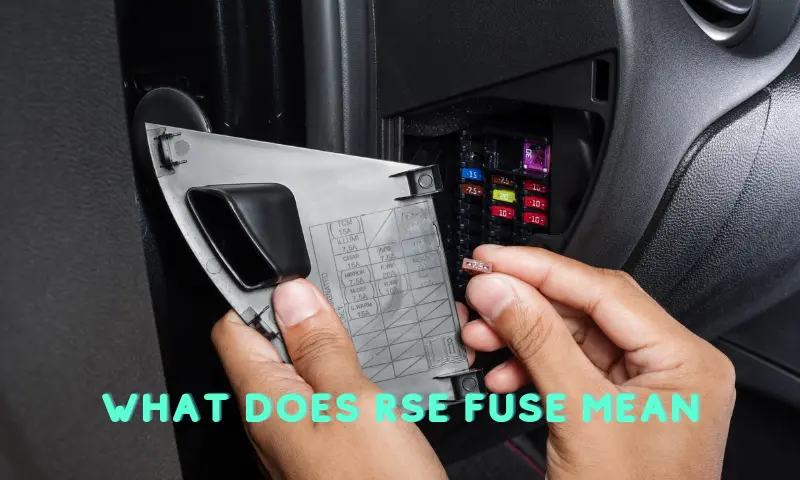I welcome you to another session on my blog. Today, I’ll be talking to you about the Rear Seat Entertainment (RSE) fuse. What does it mean? Where is it located and what function does it perform? What symptoms does the RSE error code indicate? What are other questions auto owners frequently ask? All these and more get attention and it promises to be an exciting time with your auto guru. Stay connected.
What is RSE and How does it Work?
I’ll start with what RSE means. The Rear Seat Entertainment, shortened as RSE, is a device that helps reinforce the normal functioning of your car’s audio system. With the remote control, wireless headphones, TV displays, and A/V-AUX input, the RSE augments your car’s stereo and music. The system enables you to listen to the radio, playback music, and see the video. Plus, the RSE allows you to connect to external devices, including the games console. You can get a lot of info about the RSE in the owner’s manual. With the RSE, you can keep the sound coming from the back seat to a minimum. There‘s an RSE controller in the rear section of the center console that powers up when the RSE fuse is in good condition
What does the RSE Fuse Mean?
Having known what the RSE means, let’s now look at the RSE fuse, its meaning, function, and why it may keep blowing. From what we already knew, a fuse is an electrical safety device that offers protection to an electrical circuit from having excessive current. Like all fuses, an RSE fuse protects the RSE system from overcurrent or electrical surge. The RSE fuse is located under the hood in the fuse box and inside the driver’s do.
This 5Amp fuse shows some symptoms when it is blown. Mainly, it is responsible for powering the RSE controller. In turn, the controller can power up the rear portion of the RSE. This works mostly for all models of Chevy, including the Chevy 2005 Tahoe and 2004 suburban. If the controller fails to power, there’s a chance that the RSE fuse is blown.
Plus, a faulty RSE fuse will cause the DVD display not to come on. It doesn’t matter if everything else is working fine in the RSE system. The RSE fuse helps power your car’s stereo, radio, video, and all other entertainment-related parts. Once you notice that the DVD screen won’t come on, the first suspect is a blown RSE fuse. It might need to be changed.
Your car may fail to start hours after your kids are done watching their favorite DVD. An RSE fuse might be a culprit. When this occurs, you may receive a ‘check RSE’ message. Yet, the problem won’t stop your radio from working but your car may not turn on. The first thing to check at this point is a fresh battery. Alternatively, you may get a jump starter.
How to Locate and Replace a blown RSE Fuse?
Once you suspect that your RSE components aren’t working as they should, the first thing to check is the fuse. Is it blown? If it’s, then turn off your vehicle and allow it to cool. Head straight to the main fuse box underneath the hood. In some vehicles, the fuse block is beneath the dash in the driver’s side footwell. Unclip and open the box and check the inside cover of the box for a fuse diagram.
Once you identify the RSE fuse, unplug it using fuse pliers or pullers. Check for the melted wire element in the blown fuse. You can visually inspect this or use a multimeter or light test to be sure the fuse is blown.
Now that you’ve verified that the RSE fuse is blown, the next thing to do is to get a new fuse. Make sure the replacement fuse has the same amperage or voltage as the blown fuse you’re taking out. Besides, the new RSE fuse must be identical to the one you’re changing. Check if it is a cylindrical plastic fuse, cylindrical glass fuse, or two-prong squarish plastic fuse. Once you’ve ascertained these properties, it’s time to plug the replacement fuse into its place.
FAQs
Why won’t the bottom portion of the rear RSE work?
The reason why the bottom portion of the rear RSE won’t work is if there is a failure of the RSE fuse. A blown RSE fuse is a common problem that you’ll have to deal with. When it happens, you’ll notice that there’s no power in the RSE, especially in the base area.
All you need to do is to find the blown RSE fuse under the hood and inside the driver’s door. Inspect with a test light to be sure the fuse has melted or blown. If you can find that the RSE fuse is blown, unplug and replace it asap. Otherwise, try disconnecting the negative plug of the battery cable for about 30 seconds. Reconnect it and see if the RSE works. I’ve tried the technique on my 2005 Chevy Tahoe and it worked wonders.
Why does my car’s RSE fuse constantly blow?
An RSE fuse, like all other auto fuses, is prone to blowing. When a fuse blows, it indicates a short circuit. A device malfunctioning will cause electrical components to draw overcurrent (excessive current) than it can handle. Faulty wiring and defective switches can cause your RSE fuse to blow. When the wiring is faulty, it results in a short circuit and electrical surge which ultimately blows the fuse. On a good note, a blown RSE fuse will prevent your car engine from burning itself out or overworking.
Final Thoughts
With many fuses in your car’s fuse box, you need to understand what the RSE stands for. I understand that getting familiar with these fuse abbreviations can be tricky, but you’ve got to do it. I hope this article helps you make an informed decision about the RSE fuse.

